
A Neu pole, a tall bamboo tree with red garment strips used to dispel evil spirits during Tet (Lunar New Year) festival, was erected at Hue Imperial Citadel in Thua Thien-Hue province on January 28.
|

Neu pole installed at Hue Imperial Citadel to welcome Lunar New Year
(Photo: tintucvietnam.vn)
|
|
|
|
The installation
of the tree is a traditional ritual practice of the Vietnamese people to mark
the beginning of Tet.
The
15-metre long bamboo pole was carried out by a group of 10 men who were
dressed in the uniform of soldiers under the Nguyen Dynasty.
They were
accompanied by a guard of honour and a band of royal court music to join a
procession from Hien Nhon gate through Thai Hoa Palace to arrive at the
Ancestral Temple, where emperors of the Nguyen dynasty are worshipped.
Two other
Neu pole were also installed at Trieu Mieu and Long An temples at the
Imperial Citadel at the same time.
Also on the
occasion, the Hue Relics Preservation Centre hosted a programme offering
visitors a string of activities, including royal games, calligraphy and
martial arts performances, traditional dragon and lion dances, and a chung
(square) cake making contest.
|
Source: NDO
The People’s Committee of Lac Son district held a ceremony on April 28 to receive the provincial relic certificate for the ancient rock carving site at Suoi Co stream, located in My Thanh commune.
A special music show titled "The country is in the fullness of joy” has been held at Hoa Binh Square in Hoa Binh city in celebration of the 50th anniversary of the liberation of the South and national reunification (April 30, 1975–2025).
The People's Committee of Lo Son commune, Tan Lac district, has organised the local annual traditional stream fishing festival on April 19 - 20.
As a land deeply intertwined with human history and Vietnam’s millennia-long journey of nation-building and defence, Hoa Binh is often revered for its epic tales and legends.
Residents of Hoa Binh boast a rich cultural identity, reflected in their unique language, traditional attire, customs, and folk melodies – described as "sweet as honey, clear as a mountain stream.”
Lac Son district’s Vu ban town held the 2025 Truong Kha temple festival on April 12–13 (the 15th–16th days of the third lunar month). Since its revival in 2019, the festival has been organised every three years, preserving valuable intangible heritage while meeting the community’s cultural and spiritual needs.


